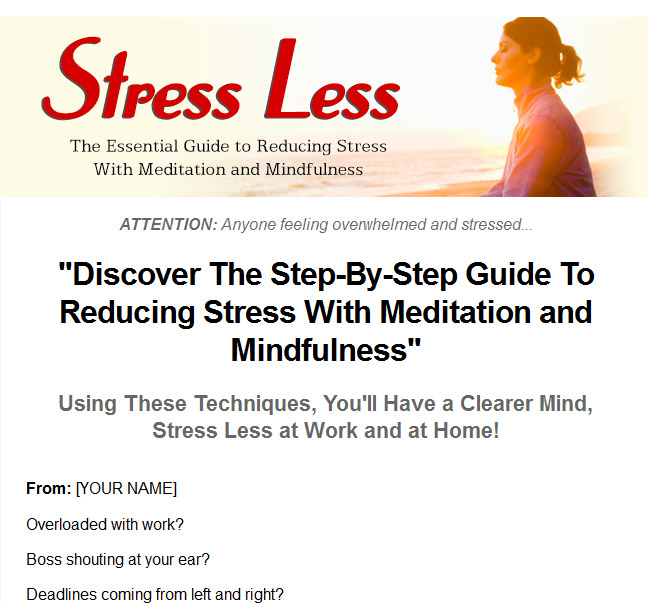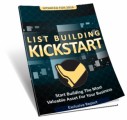Salespage Snapshot:

>>> Click Here To View Full Sales Page…
Table of Contents
Chapter 1: Why You MUST Stress Less….3
So What Exactly is Stress?4
How Stress Damages the Brain..7
Chapter 2: Understanding the Complexity of Your Stress Systems.10
How Physiological Changes Trigger Stress…11
Chapter 3: How to Manage Normal Stress…….14
Chapter 4: Meditation…….22
How to Get Started With Meditation..24
Tips..28
Correct Breathing for Stress Reduction………30
Chapter 5: Mindfulness and CBT.32
Cognitive Restructuring..34
Conclusion….36
Sample Content Preview
CHAPTER 3: HOW TO MANAGE NORMAL STRESS
Just understanding these factors, you can hopefully see that stress isn’t a ‘bad thing’ necessarily: rather it is a useful and required part of a normal, healthy, functioning body. In fact, as we’ve discussed, a little stress is necessary in order to help you feel more alert, more focused and more productive. If we never had even a small amount of stress hormones in our system, then we would spend all our time highly rested and too laid back to get any actual work done!
The key is to make sure that those stress levels stay at this optimal level, as well as to try and get your natural cycles to line up with the times when you need to be most productive during the day.
And we can start by hijacking some of the physiological aspects we’ve already discussed…
Managing Blood Sugar
One very simple way to keep your stress at bay, is to avoid letting your blood sugar drop too low. We’ve already seen that low blood sugar triggers the release of cortisol and other stress hormones and so it follows that by avoiding low blood sugar, we can avoid this fate.
The best way to manage your blood sugar levels, is to avoid consuming simple carbohydrates. Carbohydrates are the best source of blood sugar for the human body but the problem is that in their ‘simple’ form, they release energy into the blood much too quickly. This results in a sudden spike in sugar, which then gets taken up and leaves you drained again. What’s more, is that this causes the release of melatonin – the sleep hormone – as we’ve seen earlier. Not ideal for working.
If you have a breakfast that is made up of pancakes and syrup then, it will wake you up and make you feel good in the morning but an hour later you’ll start to run low on energy and that will cue the release of cortisol.
So instead, try consuming a source of calories that will release the sugar more gradually into your bloodstream. A great choice is some form of complex carbohydrate, such as oats. This takes longer to reach the blood stream, providing a steady stream of blood sugar and preventing you from going into alert ‘starvation’ mode.
Conversely, fat will also have the same effect. When you consume a saturated fat, this will once again sit in the stomach while it gets broken down, providing you with a steady release of energy that will help you go about your business throughout the day.
Stay Comfortable
Comfort is fantastic for reducing stress and this has been shown in studies to help boost creativity. It only takes your keys to be digging into your pocket for example, for your body to consider you as uncomfortable and potentially being damaged. Thus, you will find that if you can sit in a more supportive and comfortable chair and also ensure the temperature is right and you are surrounded by things that put you at ease (plants have been shown to do this well for most people), then you will start to feel a lot calmer – even when you’re at work and other stresses are being thrown at you.
Spend Time Away From Screens
Computers, smartphones and television are all great. They’re entertaining and they’re great for productivity. Unfortunately though, they’re also very bad for us when it comes to stress hormones. We’ve already discussed how light from screens can trigger the release of cortisol and we’ve seen that the constant messages and alerts essentially trigger a series of small stress responses while we’re surfing the web.
This is manageable but it becomes problematic when you spend too much time on the computer. Simply going for occasional walks and taking breaks from the screen throughout the day then will be a great way to help your body recover.
Another tip is to take time off just before bed. If you aim to have a restorative and restful night’s sleep, then you need to give yourself time to ‘wind down’ just before you hit the sack. Taking time away from computers is one of the best ways to do this, so why not have a bath before bed with some candles instead? Or read by a more natural type of light? Give yourself half an hour of ‘screen off’ time and you’ll find you get to sleep much quicker and feel more restored in the morning.
No can do? If you absolutely can’t separate yourself from your gadgets at the end of the day, then try using software that will reduce the amount of ‘blue light’ coming from the screen. Redshift technology will help you block the most damaging wavelengths from your devices and thereby create a more restful light. An alternative is to wear ‘blue blocking shades’ which can block all blue light in your environment before bed!
Get Rid of Your Alarm
You know what really isn’t helping your stress levels?
Your morning alarm!
The reason alarms tend to choose from a generic range of sounds, is that bleeps and ringing sounds are unnatural. These sounds don’t occur in nature and thus we are attuned to them and they make us naturally sit up and take notice. In other words: they trigger a stress response.
And now bear in mind that when this happens, you are often in the very deepest stage of sleep. What a way to start your day! Rudely woken from the depths of sleep by a blaring noise, only to find yourself in a pitch dark room.
There are two much healthier alternatives to consider…
Fitness Tracker
One option is to use a fitness tracker/smart watch that has a smart alarm function. These work by monitoring your heartrate and your movement during the night, in order to estimate how awake or asleep you are at any given stage. Using this information, they can then wake you up at the point when you’re in light REM sleep, rather than deep SWS sleep. The result is that you’re woken at a point when you’re already coming around anyway – and this is combined with a gentle nudge from a vibration, rather than a loud ringing.
Daylight Lamp
Better yet, is to use a daylight lamp. These are lamps that are designed to create a wavelength similar to that of the sun – with plenty of blue light! In that way, these are the opposite of redshift technology or blue blocking shades.
These lights will then be built into alarm, that are able to gradually get brighter as it nears the point that you set to wake up at. This helps to gradually stir you into wakefulness, by mimicking the effects of a sunrise. You start to feel more and more awake and your brain
Other Details- 10 Articles (TXT)
- 1 Ebook (PDF), 35 Pages
- 1 Salespage (HTML)
- 1 Squeeze Page (HTML)
- Year Released/Circulated: 2017
- File Size: 7,669 KB
License Details:
Yes You may giveaway this ebook
Yes You may resell this product.
Yes You may sell/pass resell rights/mastcr resell rights to this product
Yes You may edit the squeeze/sales page
You do NOt have Private Label (tights.
You may NOt sell or giveaway private label rights.
You may NOt re-title or edit the contents of this product
You agree to handle any own customer support issues related to this product













